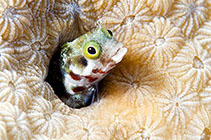http://www.fishbase.org/Summary/speciesSummary.php?genusname=Acanthemblemaria&speciesname=maria ---> http://192.134.151.83/Summary/speciesSummary.php?genusname=Acanthemblemaria&speciesname=maria
http://192.134.151.83/Summary/speciesSummary.php?genusname=Acanthemblemaria&speciesname=maria ---> https://fishbase.mnhn.fr/Summary/speciesSummary.php?genusname=Acanthemblemaria&speciesname=maria
https://fishbase.mnhn.fr/Summary/speciesSummary.php?genusname=Acanthemblemaria&speciesname=maria ---> https://fishbase.mnhn.fr/summary/Acanthemblemaria-maria.html
Acanthemblemaria maria, Secretary blenny

You can
sponsor
this page
Common name (e.g. trout)
Genus + Species (e.g. Gadus morhua)
-

-
About this page
-
Languages
-
User feedbacks
-
Citation
-
Uploads
-
Related species
-


 Secretary blenny
Add your observation in
Fish Watcher
Upload your
photos
and
videos
Secretary blenny
Add your observation in
Fish Watcher
Upload your
photos
and
videos
Pictures
|
Google image
 Acanthemblemaria maria
Acanthemblemaria maria
Picture by
Greenfield, J.
Teleostei (teleosts) >
Blenniiformes
(Blennies) >
Chaenopsidae
(Pike-, tube- and flagblennies)
Etymology:
Acanthemblemaria:
Greek, akantha = thorn + Greek, emblema, -atos, anything that is nailed, knocked in; also anything with bass or high relief (Ref.
45335
)
.
Environment: milieu / climate zone / depth range / distribution range
Ecology
Marine; reef-associated. Tropical; 18°N - 10°N, 90°W - 58°W (Ref.
56273
)
Western Central Atlantic: Bahamas (Ref.
5521
) to Tobago.
Size / Weight / Age
Maturity: L
m
?
range ? - ? cm
Max length : 5.1 cm TL male/unsexed; (Ref.
5521
)
Short description
Morphology
|
Morphometrics
Anal
spines
: 2. Species distinguished by: sides of body with series of dark bands or large oval blotches; top of head often spiny; patch of cranial spines on nape extends posterior to supratemporal commissural pore, almost to dorsal-fin origin; inner rim of posterior infraorbital bone spinous or with tuberculate spines; two or more rows of teeth on each palatine bone; dorsal fin consisting of spines and segmented rays; total dorsal-fin elements 29 to 40. Common amongst Chaenopsids: small elongate fishes; largest species about 12 cm SL, most under 5 cm SL. Head usually with cirri or fleshy flaps on anterior nostrils, eyes, and sometimes laterally on nape; gill membranes continuous with each other across posteroventral surface of head. Each jaw with canine-like or incisor-like teeth anteriorly; teeth usually also present on vomer and often on palatines (roof of mouth). Dorsal-fin spines flexible, usually outnumbering the segmented soft rays (numbering 7 to 37), spinous and segmented-rayed portions forming a single, continuous fin; 2 flexible spines in anal fin; pelvic fins inserted anterior to position of pectoral fins, with 1 spine not visible externally and only 2 or 3 segmented (soft) rays; all fin rays, including caudal-fin rays, unbranched (simple). Lateral line absent. Scales absent (Ref.52855).
Inhabits limestone slopes rather than patch reefs and these slopes are usually dotted with small brain corals, stinging coral, sea fans, whips, and sea urchins (Ref.
5521
).
Life cycle and mating behavior
Maturity
|
Reproduction
|
Spawning
|
Eggs
|
Fecundity
|
Larvae
B├Âhlke, J.E. and C.C.G. Chaplin
, 1993. Fishes of the Bahamas and adjacent tropical waters. 2nd edition. University of Texas Press, Austin. (Ref.
5521
)
IUCN Red List Status (Ref.
130435
)
Least Concern (LC)
; Date assessed:
18 October 2007
CITES
Not Evaluated
Not Evaluated
Threat to humans
Harmless
Human uses
FAO - Publication:
search
|
FishSource
|
More information
Countries
FAO areas
Ecosystems
Occurrences
Introductions
Stocks
Ecology
Diet
Food items
Food consumption
Ration
Common names
Synonyms
Metabolism
Predators
Ecotoxicology
Reproduction
Maturity
Spawning
Spawning aggregation
Fecundity
Eggs
Egg development
Age/Size
Growth
Length-weight
Length-length
Length-frequencies
Morphometrics
Morphology
Larvae
Larval dynamics
Recruitment
Abundance
BRUVS
References
Aquaculture
Aquaculture profile
Strains
Genetics
Electrophoreses
Heritability
Diseases
Processing
Nutrients
Mass conversion
Collaborators
Pictures
Stamps, Coins Misc.
Sounds
Ciguatera
Speed
Swim. type
Gill area
Otoliths
Brains
Vision
Tools
E-book
|
Field guide
|
Identification keys
|
Length-frequency wizard
|
Life-history tool
|
Point map
|
Classification Tree
|
Catch-MSY
|
Special reports
Check for Aquarium maintenance
|
Check for Species Fact Sheets
|
Check for Aquaculture Fact Sheets
Download XML
Summary page
|
Point data
|
Common names
|
Photos
Internet sources
AFORO (otoliths) |
Aquatic Commons
|
BHL
|
Cloffa
|
BOLDSystems
|
Websites from users
|
Check FishWatcher
|
CISTI
|
Catalog of Fishes
:
genus
,
species
|
DiscoverLife
|
DORIS
|
ECOTOX
| FAO - Publication:
search
|
Faunafri
| Fishipedia |
Fishtrace
| GenBank:
genome
,
nucleotide
| GloBI |
Google Books
|
Google Scholar
|
Google
| IGFA World Record |
MitoFish
|
National databases
|
Otolith Atlas of Taiwan Fishes
|
PubMed
|
Reef Life Survey
| Socotra Atlas |
Tree of Life
| Wikipedia:
Go
,
Search
| World Records Freshwater Fishing |
Zoobank
|
Zoological Record
Estimates based on models
Preferred temperature (Ref.
123201
): 27.4 - 28.4, mean 28 °C (based on 142 cells).
Phylogenetic diversity index (Ref.
82804
): PD
50
= 0.5000 [Uniqueness, from 0.5 = low to 2.0 = high].
Bayesian length-weight: a=0.00457 (0.00183 - 0.01143), b=3.08 (2.86 - 3.30), in cm total length, based on LWR estimates for this (Sub)family-body shape (Ref.
93245
).
Trophic level (Ref.
69278
): 3.4 ±0.4 se; based on size and trophs of closest relatives
Fishing Vulnerability (Ref.
59153
): Low vulnerability (10 of 100).
Nutrients (Ref.
124155
): Calcium = 190 [92, 371] mg/100g; Iron = 0.925 [0.518, 1.663] mg/100g; Protein = 18 [17, 19] %; Omega3 = 0.104 [0.051, 0.203] g/100g; Selenium = 17.5 [7.4, 42.4] ╬╝g/100g; VitaminA = 384 [117, 1,309] ╬╝g/100g; Zinc = 2.31 [1.44, 3.49] mg/100g (wet weight);
Back to Search
Random Species
Back to Top
Accessed through:
Not available
FishBase mirror site :
localhost
Page last modified by :
mrius-barile
- 20 July 2016
Fatal error
: Uncaught ArgumentCountError: Too few arguments to function checkEcotox(), 1 passed in /var/www/html/summary/speciessummary.php on line 2304 and exactly 3 expected in /var/www/html/includes/speciessummary.lib.php:2579 Stack trace: #0 /var/www/html/summary/speciessummary.php(2304): checkEcotox() #1 {main} thrown in
/var/www/html/includes/speciessummary.lib.php
on line
2579
|